Poetry, Song, and the Voice in the Piano Nocturne
by James Parakilas
Abstract
It is easier to assert that Chopin wrote the defining examples of the piano nocturne than to say how they define it, since his nocturnes overlap so frequently with other piano genres—including the barcarole, the lullaby, and the march—especially in rhythmic nature. A way to come to terms with this ambiguity, as well as with other questions about the generic identity of the piano nocturne, is to investigate their vocal model: not the operatic model that is most often considered to have inspired the lyrical style of piano nocturnes, Chopin’s in particular, but the vocal nocturne, for which the piano nocturne (starting with Field) was named. The vocal nocturne of the early nineteenth century was a Parisian specialty, a duet set to a love poem, but not a love duet—rather, a duet for two female or one female and one male singer, rapturously expressing the sentiments of the poems—usually male speaker. The piano nocturnes of Chopin derive their characteristic duet melodies and rapturous expression from that model. More surprising, perhaps, is that the characteristic rhythmic types of the Chopin nocturnes–such as the barcarole and march rhythms–also find their source in the Parisian vocal nocturne, where they are the musical embodiment of metaphors for love found in the poetic texts.
Article
Chopin’s conception of musical genres attracts attention not only because he favored generic titles for his compositions, but also because in many cases he wrote what have become the defining examples of the genre. Of course, to say that he wrote the defining examples of the ballade or the mazurka or the nocturne is to beg the question of what they define. The nocturne has proven a particularly difficult case—and therefore a rich subject for consideration—because it is not easily defined either through internal investigation (looking for common qualities in all the Chopin nocturnes) or through external investigation (holding those works up against whatever can be considered to have been Chopin’s models).
From internal investigation, all that has emerged as definitive is that the Chopin nocturnes are generally lyrical in style—often elaborately lyrical, but sometimes very plainly so. Otherwise, there does not seem to be a defining nocturne form or nocturne character or nocturne texture, and above all there is no defining nocturne rhythm. A defining rhythm might be expected above all because in general Chopin seems to have associated each genre he employed with a particular rhythmic nature, not only when working in dance genres where a defining rhythm was a given, but even when it was not, as in the ballade or the impromptu. In the case of his nocturnes, however, the opposite seems to be true. In their rhythmic nature they are distinguished more by overlap with other genres than by distinction from them: we often hear the rhythm of a barcarole or lullaby, sometimes of a march, occasionally of a hymn, at least once of a mazurka[1],and so on. And—to reach now from the internal realm to the external—the same can be said of Chopin’s great predecessors in the genre, the nocturnes of John Field.
In this dilemma we can be grateful for the wisdom of Jeffrey Kallberg, whose reflections on the question of genre in a Chopin nocturne led him to suggest that we think of genre less as “classification” than as “communication” between composer and audience[2]. What, then, might the title nocturne have communicated to Chopin’s potential customers? Poetic or dramatic associations of the word nocturnal, or musical associations with earlier piano pieces of the same title (like Field’s) or with vocal music that bore the same generic designation? It is hard to know, and if we want to follow up the associations with vocal music, there is a further difficulty. When critics have sought the stylistic roots of the piano nocturne in vocal music, they have turned almost invariably to the richly embellished vocal lines of early nineteenth-century Italian opera (in the case of Chopin, the example of Bellini is most frequently cited)[3]. But Field and Chopin are unlikely to have chosen the title nocturne to draw their public’s thoughts toward operatic models since that designation was seldom given to operatic numbers in their day, whereas it was used endlessly in a homelier species of vocal music[4].
Today it takes some sorting to discover just which homely vocal species Chopin’s customers would have thought of when they saw the name nocturne. In the German-speaking lands the term nocturne or notturno had long been used as an alternative to serenade, referring to songs imagined as being sung by a man at night under the window of the woman he was courting, though often in practice they were part-songs for male voices[5]. When piano nocturnes came along, German musicians pronounced them to be derived from that vocal genre. Carl Czerny, for instance, wrote in 1839 that:[6]
The Notturno for the Pianoforte is really an imitation of those vocal pieces which are termed Serenades, and the peculiar object of such works—that of being performed by night, before the dwelling of an esteemed individual—must always exercise an influence upon its character.
Ever since Czerny’s day, this linkage to the male vocal genre of the serenade has been central to definitions of the piano nocturne in German-language studies and music dictionaries, and it recently provided Kallberg with evidence for his case that the piano nocturne as a genre should be understood as a male construction of the sensibility of a woman being serenaded by a male suitor[7].
Meanwhile, however, there was another, fairly distinct species of vocal nocturne, established by the very beginning of the nineteenth century and flourishing throughout Chopin’s life. The creation of Italian composers, the most important of whom, Felice Blangini (1781-1841), spent his entire career in Paris, it was taken up by French composers like Auguste Panséron (1796-1859) and Antoine Romagnesi (1781-1850). These composers were extremely popular in their day as singers, teachers of singing, and composers of vocal music—comic operas as well as salon vocal music. They made the nocturne both a fixture of the Paris salon and, through publication by Parisian publishers, a symbol of the Paris salon throughout Europe. If we think of a generic title as a device of communication between composers and audiences, then surely the two primary composers of piano nocturnes would have counted on the title nocturne to evoke the Parisian vocal nocturne far more readily than its German cousin, since John Field was living and publishing his nocturnes in St. Petersburg—a city where the upper classes were French in language and culture—and Fryderyk Chopin wrote and published most of his nocturnes in Paris itself.
Nevertheless, even scholars who have noticed the existence of the Parisian vocal nocturne repertory have not until now investigated that repertory as a source of inspiration for the piano nocturne. The present study (along with a study by Jeffrey Kallberg just published)[8] is designed to remedy that neglect; it is motivated by the belief that the vocal nocturne, because it was a shared point of reference between composers and audiences of the piano nocturne, can help us resolve some of the issues that make the piano nocturne so elusive a genre to define.
The first thing to be said about the Parisian vocal nocturne is that it was almost invariably a duet, with piano accompaniment. In Chopin’s day, the nocturne seems to have been the duet variant of the solo romance. In fact, nocturnes were frequently published in collections that also included romances, as well as chansonnettes and other genres, and the principal distinction between the nocturnes and the other genres is clearly that the works in the other genres are solos, while the nocturnes are for two voices as a rule, and never fewer than two. In fact, that seems to be the sole distinction that the different titles convey: the texts of romances usually have nocturnal settings, just as those of nocturnes do, while the texts of nocturnes are generally about romantic love, just as those of romances are.
The next thing to say about these duets is that at least one of the singers called for was a woman; that is, nocturnes were written for two sopranos, or soprano and tenor, or less frequently some other combination. In other words, the Parisian nocturne was by no means cast for serenading men. And that vocal casting fits with the typically top-dominated textures of the piano nocturne. It cannot be claimed that the nocturnes of Field or Chopin or other early-nineteenth-century composers always imitate a vocal duet, but they almost always suggest a soprano voice, and somewhere along the way—especially in Chopin’s nocturnes—there is usually some suggestion of a second voice, most frequently another woman’s voice[9]. In fact, one of the wonders of the Chopin nocturnes is his infinite inventiveness in playing on the idea of a duet in close harmony.
It may seem that in the singing of love poetry, a performance by two sopranos signifies something very different from a performance by a soprano and a tenor. But even though the performance may be given by two singers, the poetry they sing does not on the whole embody two distinct roles; on the contrary, the two singers sing a single poetic text, representing a single persona, or “voice.” Sometimes that persona is ungendered, speaking to a love object also ungendered. Occasionally it is a female persona, speaking to or about a male lover. More often the persona is male. But that does not stop the composer from setting the poem for two sopranos to sing, or for one soprano and one tenor. An example is Auguste Panséron’s nocturne “La nuit s’est endormie” (see Example 1).

The text of this nocturne takes us into the bed of a couple who have spent the night together. We presume that the speaker is male because he addresses his lover in words that identify her as female: “Quittons-nous, mon amie” [Let’s take leave of each other, my beloved]. Later he also addresses her as “Belle d’amour.” But the music is to be sung by two sopranos. So, what is going on?
In the first place, we should hardly expect any exact correspondence between the singer and the song: singers have always appropriated songs that apparently belong to the opposite sex, and audiences have always accepted that[10]. In the early nineteenth century in particular, audiences were quite accustomed to hear at the opera the sort of gender bending that we find in “La nuit s’est endormie”: the roles of male lovers might be sung by castratos or by women, so that in either case the audience would be treated to love duets sung by two high voices. Presumably this effect provided the frisson of displaying a relationship that was transgressive but at the same time safe: the sight and sound of two women singing rapturously together was permitted, in effect, because they were representing, say, Romeo and Juliet, just as that particular Romeo and Juliet were permitted to express themselves in more explicitly sexual music than a male Romeo and female Juliet might be, precisely because they were not a man and woman singing together.
A love duet sung by two women owed its effect not simply to the idea of gender-bending, but also to the sound they produced. Two high voices endlessly and closely entwining with each other could provide the most exquisitely sexual pleasure because they exquisitely embodied the union of two people, regardless of their relative sexual identities, as a sound. And the astonishing thing about the piano nocturne—especially Chopin’s—is how it manages to convey the sexually exciting sound of those two intertwining high voices without using voices at all. A passage from Chopin’s E-flat Nocturne, Op. 55, no. 2, a duet full of mutual incitements and responsive sighs, illustrates just one side of this art (see Example 2).
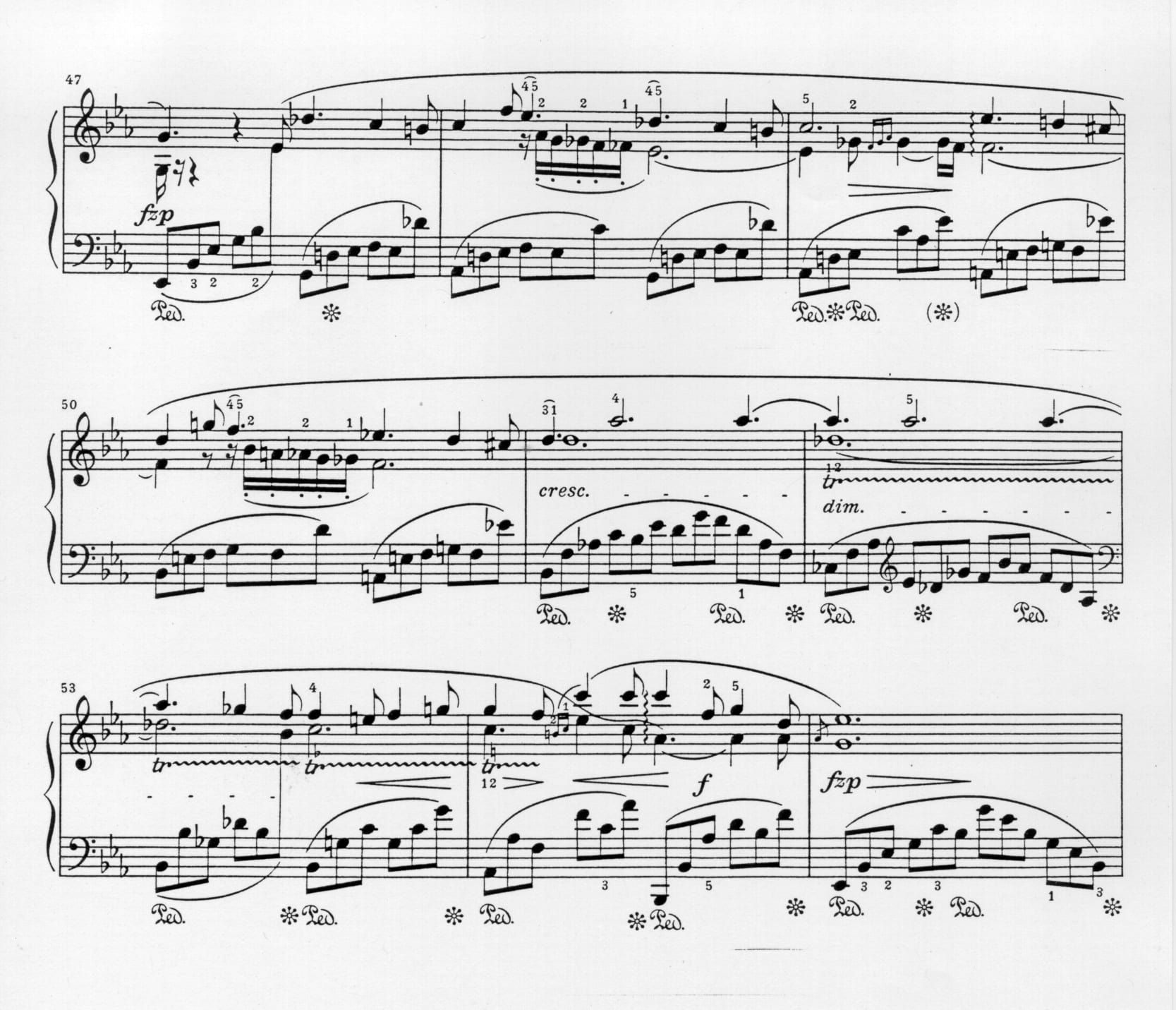
Now let us see what light the Parisian vocal nocturne can shed on the issue raised earlier about the piano nocturne as a genre that has no distinctive rhythmic character, but rather borrows the rhythmic characters of other genres. As it happens, the vocal nocturne does the same thing; in fact it borrows pretty much the same set of rhythmic characters from other genres. But vocal nocturnes do have texts, and we can explore those texts in an effort to make sense of the rhythmic variety of their music. The key to understanding this variety, I believe, is that though nocturne texts are almost all love poems, they elaborate different poetic conceits, and it is from those conceits that the musical settings derive their different rhythmic characters. It may seem strange for a duet about love to be in march rhythm, for instance, but take a nocturne by Felice Blangini in which the text tells us about the fleetingness of love through an image of lightning:
Come fugace lampo disparve in un momento . . .
[As a fleeting stroke of lightning disappears in a moment . . .]
Blangini uses a march rhythm, with offbeat accents, to capture the forcefulness and abruptness of that lightning—and by extension of love (see Example 3).
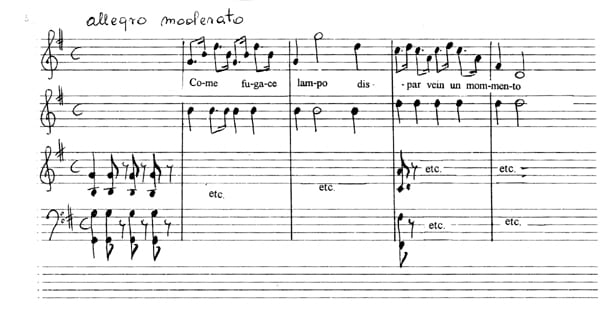
from Blangini, Eight Italian Notturnos
for two voices, Op. 21&22 (London: Birchall, n.d.), mm. 15.
Such effects make it possible to understand how Chopin nocturnes that open with march like basslines (examples are the Nocturnes Op. 37, no. 1; Op. 48, No. 1; Op. 55, no. 1; and Op. 62, no. 2) can have satisfied listeners—if we imagine listeners steeped in the vocal nocturne repertory—that they were songs of love rendered on the piano.
Another case is the nocturne in the religious mode. Quite a number of nocturne texts play shamelessly on the idea of religion as a cover for sexuality, conflating in the process two apparently opposed images of nighttime—as a time for prayerful devotion and as a time for lovemaking. Antoine Romagnesi set a “Prayer to Saint Germaine” that calls on the saint to pray for all the lovers in Paris:
Show yourself favorable to our loves!
Only good hearts are made for passion [11].
Another nocturne by Auguste Panséron, “Gentille nonnette,” is a man’s appeal to a gentle young nun, who prays every day by herself, to intercede with God for a poor sinner, apparently himself. In the first verse, the tone of his address to her—”speak to the Lord, speak to Him, my dear, of the poor sinner”—already suggests that the little nun is the object of his desire at the same time that she is expected to be the means of saving his soul from that desire. This ambiguity is even more explicit in the third and final verse as he conflates her saintliness with her attractiveness, her intercessions with lovemaking:
| Votre bouche pure |
|
| Et votre ferveur, |
|
| Des maux qu’il endure |
|
| Guériront son coeur. |
|
It is this poetic blurring of chaste prayer with sexual passion that explains how a nocturne could be a love song—in this case for soprano and tenor—set in the style of a hymn. It may also explain why the hymn-like music of this nocturne takes such lurid turns to the minor mode as the man calls on the nun to speak to the Lord “of the poor sinner,” repeating the phrase “the poor sinner” three times (see Example 4).
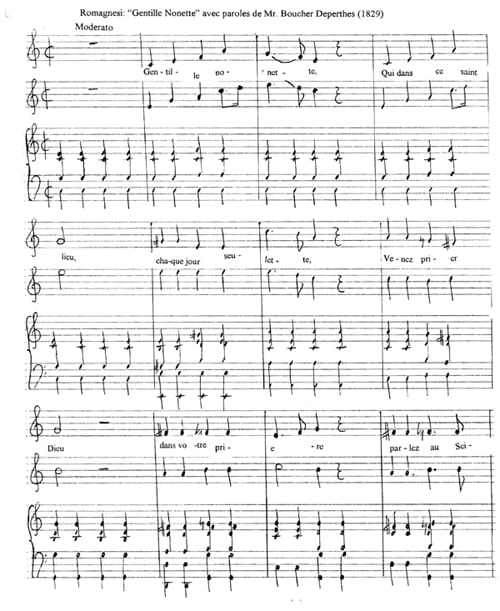
vol. 2 (Paris, chez l’Auteur).
Here too the exploration of poetic texts in the vocal nocturne lends some rationale to what otherwise seems like the intrusion of an alien genre into the piano nocturne. There are several hymn passages in the Chopin nocturnes (Op. 15, no. 3, mm. 89ff., Op. 37, no. 1, mm. 41ff., Op. 48, no. 1, mm. 25ff.), and each of them intrudes on music of a more lyrical and passionate nature—music that seems more appropriate for a song of love. The piano nocturne, lacking a text, evidently needs an episodic construction to express contradictions of tone; and so, while Panséron can play religion off against sexual passion by introducing lurid modulations within a duet that is entirely hymn-like in texture, Chopin characteristically plays one against the other by embedding a hymn passage that is itself entirely calm—perhaps as a reminder of religious possibilities or memories—within a song of passion (see Example 5).

From the hymn let us turn to the lullaby and the barcarole, if we can even tell them apart. Like the devotional hymn, the lullaby is a genre representing an innocent nocturnal activity that can cover for a more passionate one. In Panséron’s nocturne, “Protčge notre amour,” for instance, the lover speaks of nightfall as the time when everyone heads off to sleep— the fisherman makes it home, the bird finds its nest (see Example 6).
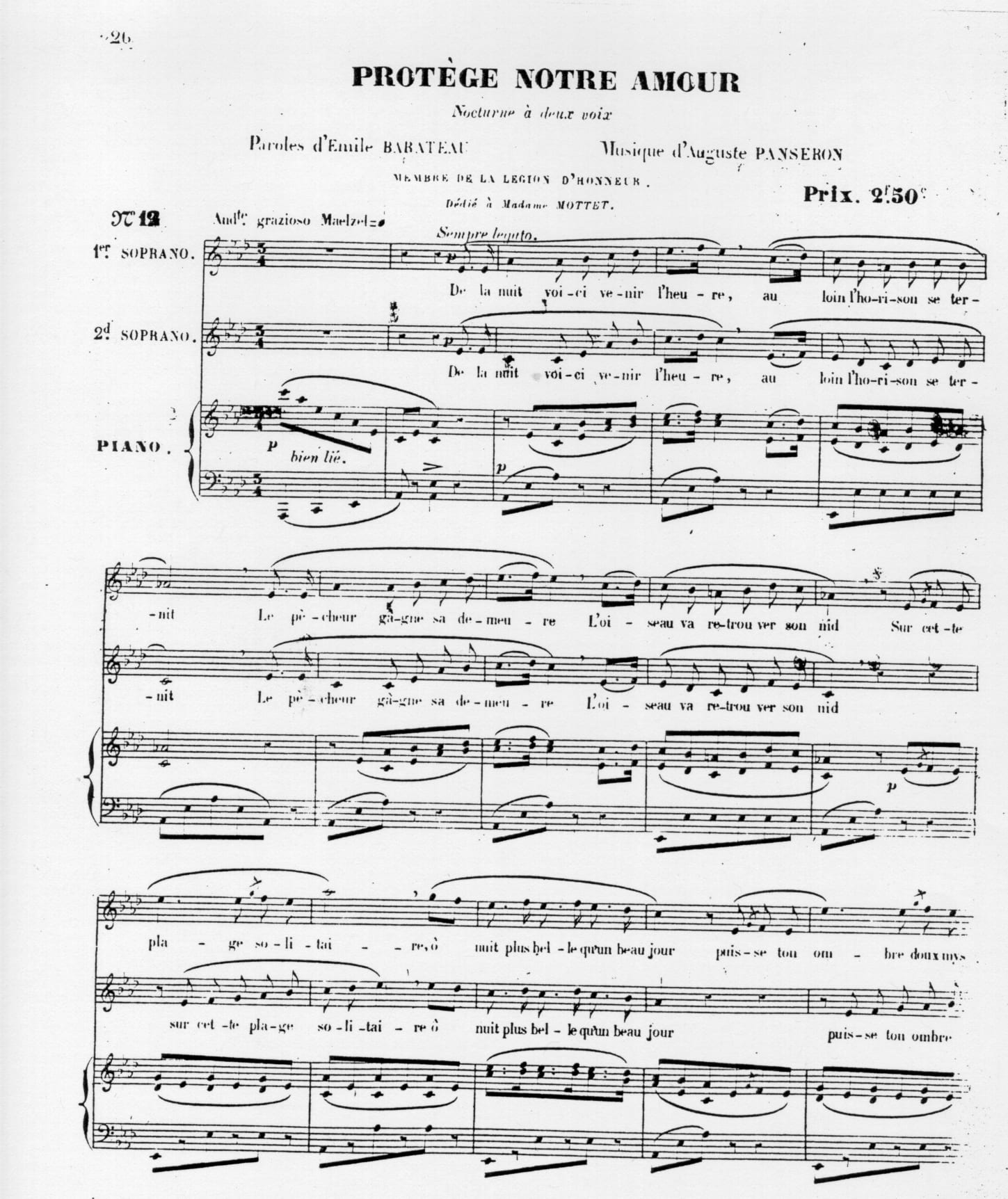
The gentle rocking of the music confirms the lullaby as the prevailing conceit of the piece. But for the lover himself and his beloved, the night has another function: to protect their love from view. It is that protecting darkness, after all, that allows him to say “ô nuit plus belle qu’un beau jour”—a line that occurs in so many vocal nocturnes that it could be called the slogan of the genre. It is no coincidence that a version of that line also occurs in the most famous of French operatic duets of love sung by two women:
| Belle nuit, ô nuit d’amour, |
| Souris à nos ivresses. |
| Nuit plus douce que le jour, |
| O belle nuit d’amour. |
Though Offenbach doesn’t call it that, his Barcarole is clearly a nocturne. Many vocal nocturnes are likewise barcaroles by rhythmic character, as are many piano nocturnes, Chopin’s among them. Antoine Romagnesi’s “Pensers du soir,” for instance, a nocturne for soprano and tenor or two sopranos, is a barcarole in its wavelike bass and its melodic rhythm of quarter-eighth, quarter-eighth—but also a lullaby, to judge by the line “Je me berçai d’un riant avenir” [I lulled myself with a smiling future]. The opening of this nocturne, marked by incessant repetition of its extremely simple opening phrase, fits the description given above of the vocal nocturne as a homely species of vocal music (see Example 7).
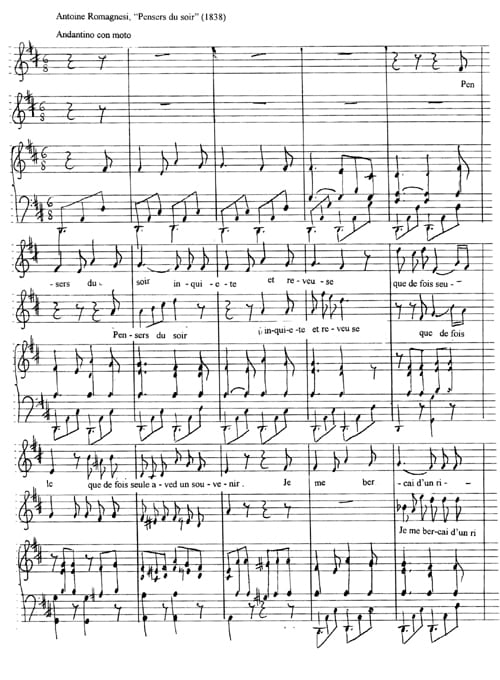
chansonnettes et nocturnes, vol.2, mm. 1-16.
But the ending of the song takes an unexpected turn to the operatic: the singers treat us to a joint roulade (see Example 8).

This phrase casts a new light on the question of how the piano nocturnes of Chopin, or for that matter Field, could so often be operatic in style—that is, of a grandly embellished lyricism—and yet be named for the vocal nocturne. The answer may be that the vocal nocturne was not a genre that entirely shunned the splendors of operatic singing. It may have been a salon genre, but the greatest singers of the Paris operatic stage also sang at Paris salons, and the composers of vocal nocturnes were also composers of operas. What is more, the apparent simplicity of sentiment and modesty of style that made the vocal nocturnes of Blangini and Panséron and Romagnesi accessible and appealing to huge numbers of amateur performers should not make us forget that to nineteenth-century artists, simplicity was an affectation. The composers of vocal nocturnes were ready to ask their singers—whether amateurs at a family gathering or the stars of the Opéra—to remove the mask of simplicity at a moment’s notice for a ravishing roulade, just as they were ready to use the image of a praying nun to convey the lustfulness of a self-styled sinner.
The vocal nocturne, in other words, turns out to be no easier a genre to define than the piano nocturne. But its ambiguities are nevertheless helpful in making sense of those of the piano nocturne. Consider one final example of duet texture in a Chopin nocturne (see Example 9).
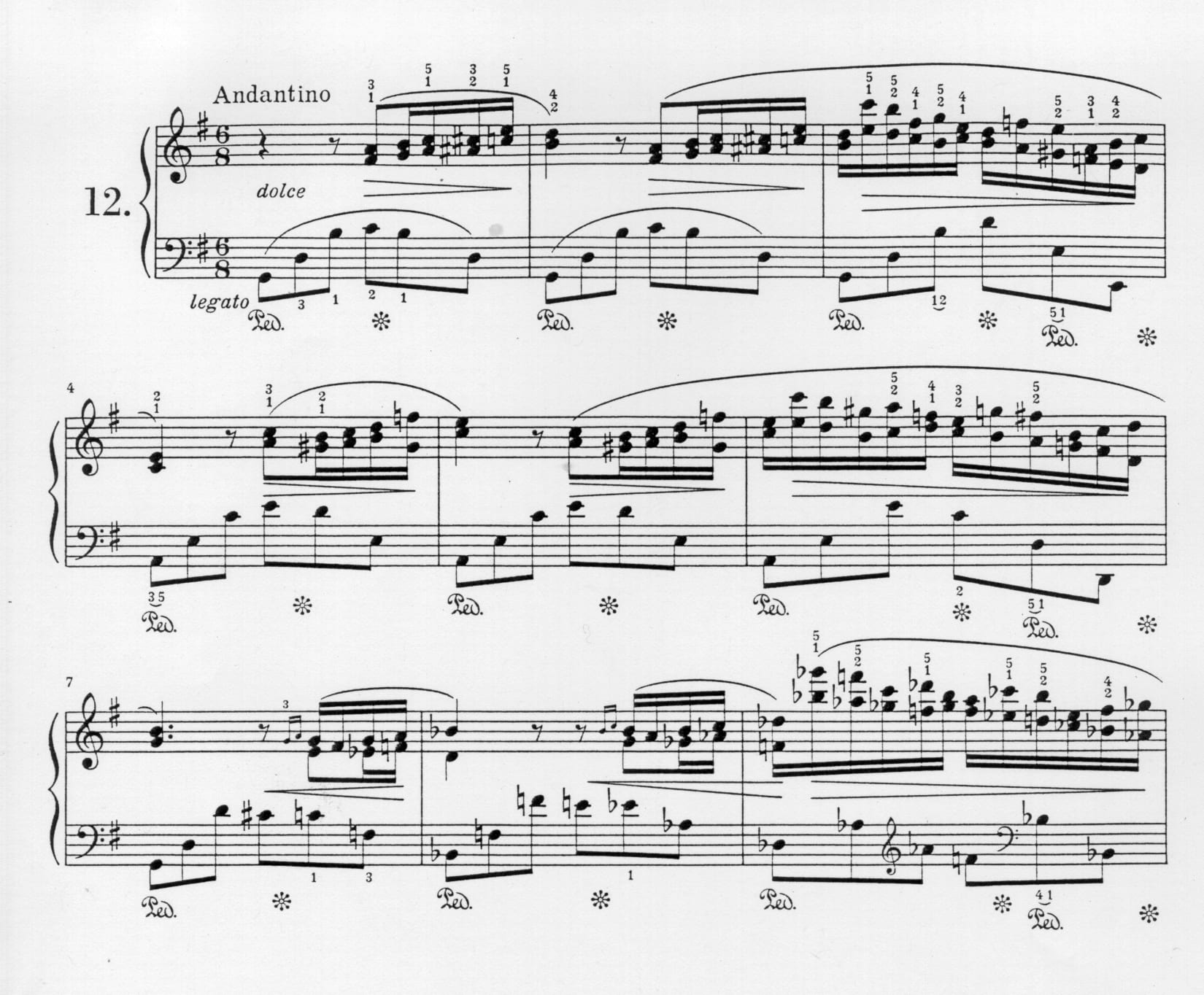
Here a duet passage—this time a sweetly harmonious, rather than a passionate love duet—is for once the opening and principal theme of a piano nocturne rather than an intensifying development. The opening of this nocturne reminds us more forcefully than any other Chopin nocturne that the principal model of the piano nocturne was a genre of vocal duets. When we think of the florid lyricism of the Chopin nocturnes, then, should we think exclusively of embellished solo lines and not at all of embellished duet lines like this? Furthermore, does this passage remind us of the opera house or of the salon? Do we connect its sweet harmoniousness with one source and its restless modulation with another? And now that we have peeked at some specimens of the vocal nocturne, why would we expect to be able to make such a distinction?
Notes
[1]. The significance of the mazurka rhythm in Chopin’s G-minor Nocturne, Op.15, no.3, is examined by Jeffrey Kallberg in “The Rhetoric of Genre: Chopin’s Nocturne in G Minor,” reprinted in his Chopin at the Boundaries: Sex, History, and Musical Genre (Cambridge, Mass.: Harvard University Press, 1996), pp. 3-29. [Back]
[2]. Ibidem, especially pp. 21-22. [Back]
[3]. Nicholas Temperley gives a representative, though judicious, assessment of the Italian operatic model: “The similarity of Chopin’s nocturnes to Bellini’s cavatinas (such as ‘Casta diva’ from Norma) has often been noticed, though there is little evidence of direct influence in either direction. The influence of Rossini’s and Weber’s operatic melodies is apparent” (“Fryderyk Chopin”, in The Grove Early Romantic Masters 1, New York and London: W.W. Norton, 1985, p.43.) Will Crutchfield has recently moved the discussion of Chopin’s operatic models from the written notes of composers like Bellini to the improvised embellishments of the singers Chopin heard performing Italian opera. (New York Times, 20 June, 1999, Arts section), pp. 21-22. [Back]
[4]. Nonetheless, music dictionary writers of the time (Castil-Blaze and Lichtenthal in particular) did maintain that an operatic type of nocturne, a number of nocturnal character or setting, was to be found in operas from as early as 1791; see Christoph von Blumroder, “Notturno/ Nocturne” in Hans Heinrich Eggebrecht, ed., Handworterbuch der Musikalischen Terminologie (Wiesbaden: Franz Steiner, 1982) p. 6. [Back]
[5]. See ibidem, especially pp.4-5. [Back]
[6]. Carl Czerny, School of Practical Composition: or, Complete Treatise on the Composition of all Kinds of Music, Op. 600, trans. John Bishop, 3 vols. (London: Robert Cocks, 1848; reprint, New York: Dacapo, 1979) vol.1, p.97. [Back]
[7]. See Wolfgang Krueger, Das Nachtstuck: Ein Beitrag zur Entwicklung des einsatzigen Pianofortestuckes im 19. Jahrhundert (Munich: Emil Katzbichler, 1971) and von Blumroden, “Notturno/ Nocturne”; Kallberg, “The Harmony of the Tea Table: Gender and Ideology in the Piano Nocturne,” reprinted in his Chopin at the Boundaries, esp. pp.45-47. [Back]
[8]. Kallberg’s study, “Voice and the Nocturne,” appears in Bruce Brubaker and Jane Gottlieb, eds., Pianist, Scholar, Connoisseur: Essays in Honor of Lateiner (Stuyvesant, NY: Pendragon, 2000), pp. 1-46. The two studies were prepared independently of each other. [Back]
[9]. Suggestions of a second voice are rarer and slighter in Field’s earliest nocturnes (several of which, in any case, were originally published as romances rather than nocturnes), but in the later ones (as for example, the eleventh, in E-flat, of 1833) he sometimes develops a second “voice” at length, in either the tenor or mezzo soprano range. [Back]
[10]. See Mark W. Booth, The Experience of Songs (New Haven: Yale University Press, 1981), pp. 14-17. [Back]
[11]. “A nos amours montrez vous favorable! /Les bons coeurs seuls sont faits pour s’enflammer.” Antoine Romagnesi, “Priere a Ste. Germaine” (words by Simonnin) in Romagnesi, Etrennes lyriques: recueil compose de romances, nocturnes, contredances, walses et galops (Paris: chez I’Auteur, n.d.) [Back]
James Parakilas is acting chair of the Music Department and past chair of the Humanities Division at Bates College in Lewiston, Maine. He holds the PhD in Musicology from Cornell University and other degrees from Amherst College, Yale University, and the University of Connecticut. He is the author, with collaborators, of Piano Roles: Three Hundred Years of Life with the Piano (Yale University Press, 2000). This book, which forms part of the project Piano 300 under the leadership of the Smithsonian Institution, has been awarded the 2000/2001 award of the Association of American Publishers (Professional and Scholarly Publishing Division) for the outstanding book in the Arts category. His other scholarly publications include Ballads without Words: Chopin and the Tradition of the Instrumental Ballade (Amadeus Press, 1992); a critical anthology of piano ballades (A-R Editions, 1990); and articles on musical exoticism (including “The Soul of Spain” in The Exotic in Western Music, ed. Jonathan Bellman), musical historicism, the formation of musical canons, political and religious representation in nineteenth-century opera (including “Religion and Difference in Verdi’s Otello” in Musical Quarterly), and Bartók’s folksong arrangements as a project in nationalist pedagogy (also Musical Quarterly). From 1995 to 1998 he was co-editor of the Journal of Musicological Research.